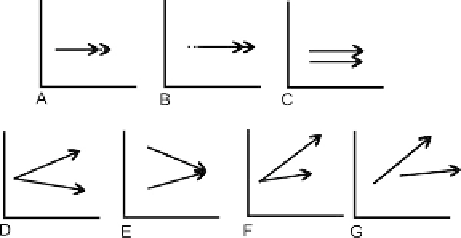Biology Reference
In-Depth Information
HYPOTHESES ABOUT THE EVOLUTION OF ONTOGENETIC
TRAJECTORIES
Until recently, most studies of evolving ontogenies focused on three possibilities:
(1) ontogenetic scaling; (2) heterochrony; and (3) “transpositional” allometry. None of
these three alter the ontogenetic trajectory. These are shown as vectors in a two-dimen-
sional shape space (
Figure 11.10A
, B, C), which makes the contrasts among them easiest to
see but which precludes depicting the relationships between shape and size or age. The
first two alter the relationship between shape and either size or age, and the first is actu-
ally a special case of the second. In the case of ontogenetic scaling (
Figure 11.10A
), the des-
cendant's shape can be predicted from the ancestral regression equation
the descendant
has the shape that the ancestor would at the descendant size. So, if the descendant grows
to a larger size, the descendant juvenile has the shape of the ancestral adult. Conversely, if
the descendant grows to a smaller size, the descendant adult has the shape of the ancestral
juvenile. The evolutionary change in shape thus results from the difference in rate or tim-
ing of growth as increases or decreases in growth rate, or longer or shorter durations of
growth, alter the descendant's adult size. In the second case, it is the relationship between
shape and age that is altered (
Figure 11.10B
). The descendant has the shape predicted for
a younger or older ancestor. Ontogenetic scaling is a special case of this because ontoge-
netic scaling preserves the relationship between shape and size; in the more general case,
evolutionary changes in size and shape can be dissociated from each other. In the case of
heterochrony, it is the rate or timing of shape change relative to age that is modified. The
shape of the descendant appears in ancestral trajectory or can be obtained by extrapolation
of that ontogeny, but the regressions of shape on age or size are not identical.
Heterochrony, and the special case of ontogenetic scaling, are encompassed by the classic
definition of heterochrony (
Gould, 1977; Alberch et al., 1979
).
The third case is called “transpositional” allometry because the two trajectories are
identical; it is just that one is translated (transposed) along the y-axis relative to the other
(see
Figure 11.10C
). In this case, the trajectories point in the same direction, but the ontoge-
nies diverged before the youngest observed age. As a result, the trajectories are parallel
rather than coincident. At no point subsequent to divergence (and therefore, at no point in
the observed phase of development) does the shape of the descendant appear in the ontog-
eny of the ancestor. The two are consistently different
the same features that distinguish
the two at birth distinguish them as adults. It is possible that the ancestor and descendant
FIGURE 11.10
Hypotheses about the evolution
of ontogenetic trajectories drawn as two vectors in
a two-dimensional shape space. Three hypotheses
predict no change in the ontogenetic trajectory of
shape (A, B, C). The remaining three predict
change in the ontogenetic trajectory of shape and
early morphogenesis (D, E) and/or lengths of the
ontogenetic trajectories (F, G).




